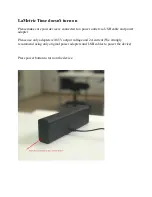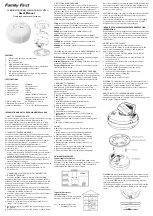
–
5
–
Supported Notification Type:
Heat Alarm
Heat Alarm Supported Event:
1. Overheat detected, unknown location (0x02)
2.
Heat Alarm Test (0x07)
3.
Replacement required, End-of-life (0x08)
4.
Alarm silenced (0x09)
Important Safety Information:
1.
The test button accurately tests smoke alarm functions. Do not use any other test method. Test the
smoke alarm weekly to ensure its proper operation.
2.
If you're sure it isn't a real alarm, open windows or fan air around the smoke alarm to test and silence it.
3.
Users installing this product need to comply with all local and national electrical installation and building
codes.
4.
This smoke alarm is designed to be used inside single family homes only. In multifamily buildings, each
individual living unit should have its own smoke alarms. Do not install it in non-residential buildings as
this smoke alarm is not a substitute for a complete alarm system.
5.
Install a smoke alarm in every room and on every level of the home. Smoke may not reach the smoke
alarm for many reasons. For example, if a fire starts in a remote part of the home, on another level, in a
chimney, wall, roof, or on the other side of a closed door, smoke may not reach the smoke alarm in time
to alert household members. A smoke alarm will not promptly detect a fire except in the area or room in
which it is installed.
6.
The smoke alarm may not alert every household member every time. The alarm horn is loud in order to
alert individuals to a potential danger. However, there may be some circumstances where a household
member may not hear the alarm (i.e. outdoor or indoor noise, sound sleepers, drug or alcohol usage, the
hard of hearing, etc.). If you suspect that this smoke alarm may not alert a household member, install
and maintain specialty smoke alarms. Household members must hear the alarm’s warning sound and
quickly respond to it to reduce the risk of injury, or death that may result from fire. If a household mem-
ber is hard of hearing, install special smoke alarms with lights or vibrating devices to alert occupants.
7.
Smoke alarms can only sound their alarms when they detect smoke or detect combustion particles in the
air. They do not sense heat, flame or gas. This smoke alarm is designed to give audible warning of a de-
veloping fire. However, many fires are fast - burning, explosive or intentional and others are caused by
carelessness or safety hazards. In such circumstances, smoke may not reach the alarm
QUICKLY ENOUGH
to ensure safe escape.
Therefore the installation of smoke alarms is not a substitute for practicing fire
safety in the home.
8.
Smoke alarms have limitations. This smoke alarm is not foolproof and is not warranted to protect lives or
property from fire. Smoke alarms are not a substitute for insurance. Homeowners and renters should
have adequate insure to protect their lives and property. In addition, it is possible for the smoke alarm to
fail at any time. For this reason you must test the smoke alarm weekly and replace them every 10 years.
Do Not Install Smoke Alarms in the Following Places:
1.
Near appliances or areas where normal combustion regularly occurs (kitchens, near furnaces, hot water
heaters).Use specialized smoke alarm device with unwanted alarm control for these areas.
2.
In areas with high humidity, like bathrooms or areas near dishwashers or washing machines. Install the
smoke sensor at least 10 feet (3 meters) away from these areas.
3.
Near air returns or heating and cooling supply vents. Install smoke sensors at least 3 feet (1 meter) away
from these areas. The air could blow smoke away from the detector, interrupting its alarm.
4.
In rooms where temperatures may fall below 0 °C or rise above 40 °C, or in humidity higher than 93%.
These conditions will reduce battery life or cause false alarms.
5.
In dusty, dirty or insect
–
infested areas particles interfere with the smoke alarm device operation.


































